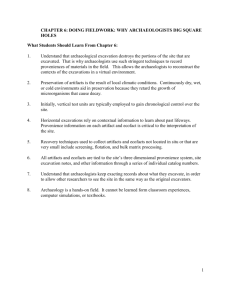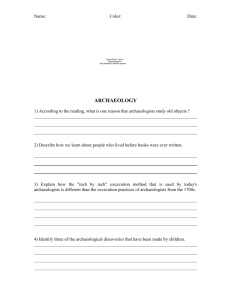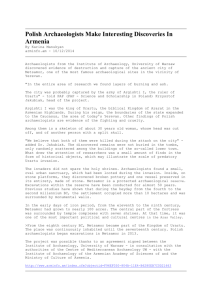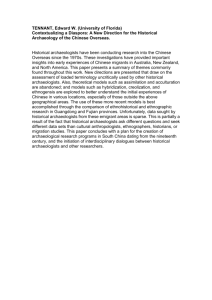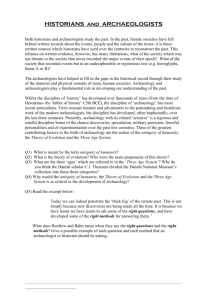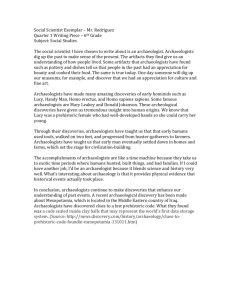Name - Wappingers Central School District
advertisement
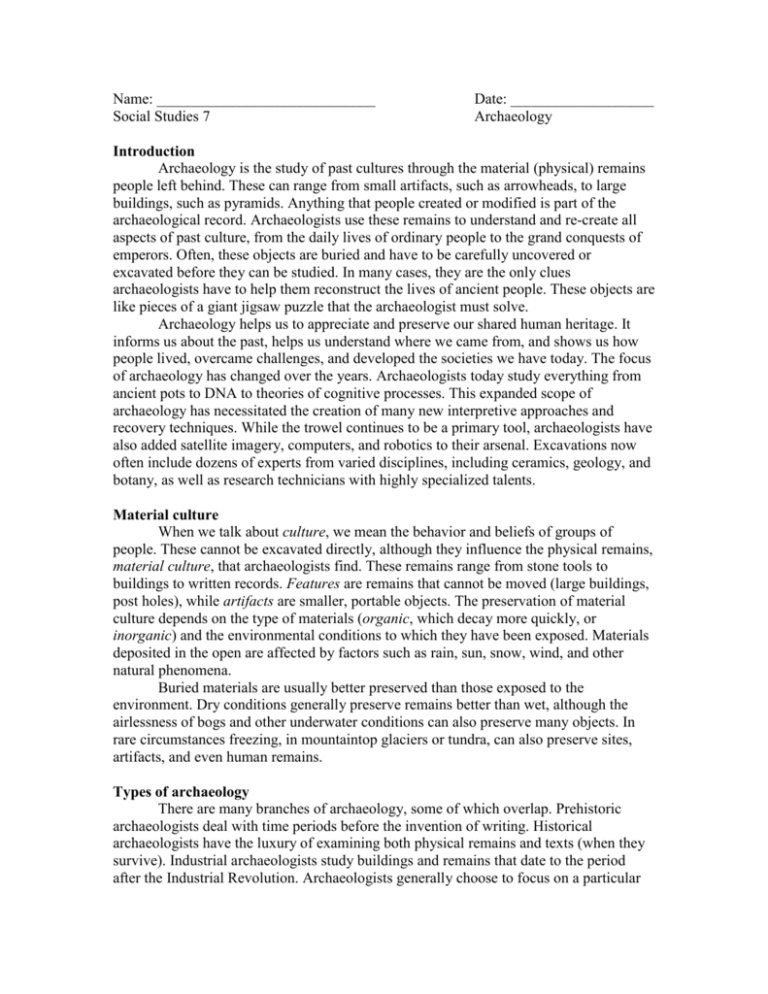
Name: _____________________________ Social Studies 7 Date: ___________________ Archaeology Introduction Archaeology is the study of past cultures through the material (physical) remains people left behind. These can range from small artifacts, such as arrowheads, to large buildings, such as pyramids. Anything that people created or modified is part of the archaeological record. Archaeologists use these remains to understand and re-create all aspects of past culture, from the daily lives of ordinary people to the grand conquests of emperors. Often, these objects are buried and have to be carefully uncovered or excavated before they can be studied. In many cases, they are the only clues archaeologists have to help them reconstruct the lives of ancient people. These objects are like pieces of a giant jigsaw puzzle that the archaeologist must solve. Archaeology helps us to appreciate and preserve our shared human heritage. It informs us about the past, helps us understand where we came from, and shows us how people lived, overcame challenges, and developed the societies we have today. The focus of archaeology has changed over the years. Archaeologists today study everything from ancient pots to DNA to theories of cognitive processes. This expanded scope of archaeology has necessitated the creation of many new interpretive approaches and recovery techniques. While the trowel continues to be a primary tool, archaeologists have also added satellite imagery, computers, and robotics to their arsenal. Excavations now often include dozens of experts from varied disciplines, including ceramics, geology, and botany, as well as research technicians with highly specialized talents. Material culture When we talk about culture, we mean the behavior and beliefs of groups of people. These cannot be excavated directly, although they influence the physical remains, material culture, that archaeologists find. These remains range from stone tools to buildings to written records. Features are remains that cannot be moved (large buildings, post holes), while artifacts are smaller, portable objects. The preservation of material culture depends on the type of materials (organic, which decay more quickly, or inorganic) and the environmental conditions to which they have been exposed. Materials deposited in the open are affected by factors such as rain, sun, snow, wind, and other natural phenomena. Buried materials are usually better preserved than those exposed to the environment. Dry conditions generally preserve remains better than wet, although the airlessness of bogs and other underwater conditions can also preserve many objects. In rare circumstances freezing, in mountaintop glaciers or tundra, can also preserve sites, artifacts, and even human remains. Types of archaeology There are many branches of archaeology, some of which overlap. Prehistoric archaeologists deal with time periods before the invention of writing. Historical archaeologists have the luxury of examining both physical remains and texts (when they survive). Industrial archaeologists study buildings and remains that date to the period after the Industrial Revolution. Archaeologists generally choose to focus on a particular culture that often is associated with a chronological period: classical archaeology covers the civilizations affected by the Greeks and Romans, Egyptian archaeology deals with Egypt; Mesoamerican archaeology focuses on cultures in Central America and Mexico, and so on. Techniques and tools Archaeologists use many tools, some created for them, and others borrowed from other fields. Common archaeological tools include shovels and trowels to loosen dirt, brooms and brushes to sweep the loose dirt, buckets to carry the dirt, and sieves to screen it. In addition to these usual tools, archaeologists utilize any object that can be used to carefully move earth and uncover objects. For very fine and delicate excavations, archaeologists use dental picks, brushes, spoons, and very fine blades. For larger scale operations, archaeologists may use large earthmovers, such as bulldozers and backhoes, but only to remove topsoil and overgrowth. The primary tool used by most archaeologists is the flat mason’s trowel, with which they slowly scrape away the soil in horizontal motions. Scooped gardening trowels have a tendency to dig holes, which the archaeologist does not want to do. The goal is to work horizontally until all the finds in an area have been exposed and their relationships noted. Carbon-14 Dating Archaeologists often use a technique called Carbon 14 dating to determine the age of artifacts. It was developed right after World War II by Willard F. Libby and coworkers, and it has provided a way to determine the ages of different materials in archeology, geology, geophysics, and other branches of science. Some examples of the types of material that radiocarbon can determine the ages of are wood, charcoal, marine and freshwater shell, bone and antler, and peat and organic-bearing sediments. Age determinations can also be obtained from carbonate deposits such as calcite, dissolved carbon dioxide, and carbonates in ocean, lake, and groundwater sources. Questions 1. What are some of the materials archaeologists study to gain an understanding of culture? 2. What is culture? 3. List the different types of archaeologists. 4. List some tools archaeologists use. 5. Explain what carbon 14 dating.




